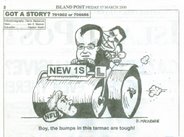Death to birds of prey
A rare bird who found sanctuary in the Western Isles after taking a wrong turn during its migration met a sad end this week.As the sad tale of the Osprey continues, the utter despair and hopelessness of it's life is neatly condensed by those who had (cruelly?) tagged it....
Moray seemed to lose all sense of direction and fly north west towards the Hebrides.Perhaps Moray knew where he was going before heading to Africa, and it was the other one that was lost, but never mind...
"A batch of signals came in during the day, and I became worried that Moray had not moved location," explained blog writer Jamie Whittle. "After examining the data carefully, including the activity counter, I was convinced that he was either dead or unable to move at Barvas."This is almost beyond satire, but I will continue anyway.
Moray's body was soon discovered in a roadside ditch, raising suspicion he may have been hit by a passing car.
With more birds killed every year by cars than are ever killed by wind farms... No! Stop now!





4 comments:
Once again Angus - you miss the point! While windfarms can and do kill birds, in many areas this is biologically acceptable mortality (replacing, not adding to natural or other mortality). In other areas, due to the presence of rare species or important migration routes, the mortality can have a significant population impact and the windfarm should be opposed. Thus the need for good planning - not WIC-style, bendover whenever you see a developer (be it a quarry or windfarm company!).
Moreover, in the case of the LWP application, the real issue was not collision risk, but loss/damage to habitat - that would have caused significant population loss, including to a protected site - hence, the Government's decision being the only legal one they could make (if that is not the case, why aren't LWP or WIC in the Court of Session yet?).
Sorry if that's too complex for you or unsuitable for an amusing blog entry - but why not consider the facts before you try to satire :)
Is there a windfarm on Sulasgeir? I heard that a large number of birds have perished there recently. Perhaps the anti-windfarm lobby in Ness could do some investigating.
Angus
With your biodiversity (former LBAP Chair - how many meetings did you actually attend?) background I am surprised you take things so literally that you read in the press. Your link to the Osprey and windfarm was flagged to me and I feel I should comment.
Sattelite tagging of birds is allowing all a greater insight into bird movements. It is a fascinating story to follow. Take a tour of Roy's site for example and see how Ospreys have migrated to Africa in the past . It is truly amazing. Have a look at the RSPB website for details of Sea Eagle tracking on Mull this autumn or Ospreys migrating south through England to the continent.
Re the bird being hit by a car. Its a maybe. As the picture on Roy's website shows it was lying in a roadside ditch in Barvas. However its body weight was significantly lower than it should have been so this is likely to be the greatest contributing factor. A PM in due course may reveal if a car did hit the bird, or what the exact cause of death was. What we do know is that the bird ended up in a corner of Britain it should not have and eventually succumbed. It took over 2 hours to find, with latterly 3 of us searching, even when we were following co-ordinates. Eventually GPS info rather than OS grid refs brought us to within c60m of the bird. Interesting to note however that the initial data suggested the bird was in Barvas Church - I presume the US military use a more accurate system for guiding missles (or not!). I digress.
Tags and windfarms. A number of marked birds have died in Norway by hitting turbines (Smola) and to date mortality at Scottish schemes has been kept low by sensible (sensitive) sitting. This shows that the process of assessment of good v bad locations works. That is why certain sites have been flagged on the islands as 'bad' and have not progressed. Developers, whether they be private individuals, communities or multi nationals have a process to follow. If this process is followed the hope is 'bad' sites will not progress.
It is interesting to note that Golden Eagle have been tagged on the islands before, but the data was not made public. Such a shame, as it showed birds moving in areas that some would rather they did not.
Finally it always brings a smile to my face when cars and birds are raised. One Councillor openly told how he runs down several eagles a week. That says a lot about that individuals and not just about his bird identification or driving skills.
What is it they say - a little knowledge is a dangerous thing. Or rather - when you bullshit you will be caught out.
Martin Scott
Is there any law that prevents us from running down several councillors in a week?
Post a Comment